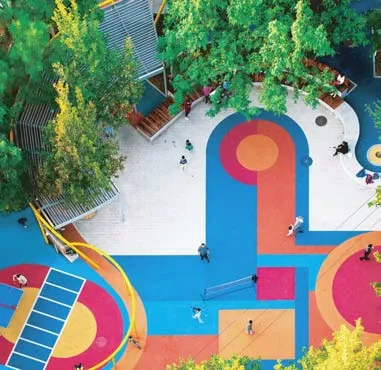城市绿地空间的开放共享
2024-02-26郑曦

城市的演变与居民的需求息息相关,它们相互影响、协调发展,如同一场共同的旅行。20世纪中期,城市聚焦于适应汽车时代,导致城市边缘与道路网络不断扩张。然而,随着时间推移,不断扩张的城市带来的问题变得明显,推动我们向可持续的城市发展迈进。如今,城市塑造更注重绿地空间的规划、布局、数量和功能,更倾向于城市绿地空间的开放共享。这不仅可以提升审美体验,也有助于增进居民福祉和提高生态效能。城市绿地的开放共享、绿地与城市形态的深度融合成为关键考虑因素,能够促进绿地空间与居民工作、休闲活动的无缝融合,提升整体城市环境的宜居体验。因此,城市绿地与城市空间的开放融合需要优先考虑可达性、无障碍设计、行人友好和高效的公共交通,使城市街道与公园绿地连接成一体。
相应地,从传统的公园管理模式转向服务治理模式是促进开放共享的关键。公园绿地的管理者与使用者合作,重新定义公园的活力,引入专业团队进行全周期陪伴式的共同管理和经营。如北京郊野公园的“百园百师”工作营方式,与知名高校合作,致力于促进充满活力的多功能公园的涌现。开放共享的公园绿地不仅融入并美化城市景观,还为培育新产业和经济活动提供了土壤。可以成为激发周边活力的催化剂,使该地区对居民和企业更具吸引力。这种创新策略为公园的维护和发展创造可持续的收入来源。
大型公园常被视为独立实体,具有预定的功能。然而,社区公园群的出现探索并突破这些功能界限,成为娱乐、社交和生态元素的缩影,深嵌入城市生活结构中。这种模式通过将公园功能分散到整个街区,深化了绿色空间与社区生活的融合。社区公园群鼓励自发的社会互动,重新利用闲置的空间,包括将空地、未使用的庭院甚至屋顶改造成绿色微空间,这种以社区为中心的城市绿地更新方法确保公园活动成为日常生活的一部分,有助于培养归属感和社区认同感。社区公园群可以提高可达性,使居民更容易享受便利设施,促进更健康、更可持续的生活方式。
随着城市更新和高质量发展,城市绿地的开放共享不仅为居民提供休闲娱乐的场所,更成为推动城市发展和塑造城市形象的重要动力。制定政策指引、明确实施路径成功推动了公园绿地开放共享,优化了公园运营,催生了新业态和新动能,成为推动城市产业结构升级和创新的重要引擎。城市绿地空间的开放共享有助于提升社区福祉、环境可持续性、文化多样性和经济活力,使城市变得更美丽、更宜居。然而,城市绿地本身的公益属性、作为生态产品的公共性、服务于居民休闲游憩活动的基本功能,以及作为城市绿地的用地性质是我们必须坚持的原则,这也是城市宜居生活和城市生态系统健康的根本保证。在未来的城市更新建设中,我们在创造“公园+”场景重塑公园活力的同时,更需要在城市其他用地类型中建设更多的“+公园”场景,以促进更加可持续、宜居、韧性的城市发展。
Opening and Sharing of Urban Green Space
The evolution of cities and the needs of inhabitants are intertwined closely with each other.With mutual interaction and jointly development, they seemingly share an identical journey.In the mid-20th century, cities were focused on adapting to the age of automobiles, causing the ever-expanding urban edges and road networks.However, over time, problems associated with such expanding environments have become prominent and are pushing us towards sustainable urban development.Nowadays, more attention is paid to the planning, layout, quantity and functionality of urban green spaces, favoring the open and sharing of such spaces.This trend would not only enhance the aesthetic experience, but also boost the well-being of residents and ecological efficiency.The opening of urban green spaces, as well as the deep integration between green spaces and urban modalities, has become key considerations, since they can create an urban environment that promotes the seamless consolidation between green space and residents’ work and leisure activities, while enhancing the overall livability experience.Therefore,the opening and integration of urban green spaces and urban spaces shall give priority to reachability, accessibility, pedestrian-friendliness,and efficient public transportation, so that city streets and parks can be connected as a whole.
Accordingly, transforming the traditional park management model to a service-based governance model is critical for promoting opening and sharing.By cooperating with users of parks and green spaces, managers can redefine the vitality of parks, and deliver fullcycle accompany-based co-management and operation by hiring professional teams.For example, under the operation model of “100 Parks, 100 Teachers” workshop, Beijing’s outskirt parks cooperate with renowned universities to promote the emergence of vibrant multifunctional parks.Open and shared parks and green spaces would not only integrate themselves into and beautify the urban landscapes,but also provide the soil for fostering new industries and economic activities.As a catalyst to activate the vibrancy of the surrounding environment, they can attract residents and businesses more widely.Such innovation strategies can create a sustainable revenue stream for park’s maintenance and development.
Large parks are usually regarded as separate entities with predetermined functions.However, the emergence of community park clusters is exploring and breaking through these functional boundaries, which have become an epitome of recreational, social and ecological elements and are deeply embedded in the fabric of urban life.By decentralizing parks’ functionalities throughout neighborhoods, such models have deepened the convergence between green spaces and community life.Community park clusters encourage spontaneous social interaction and re-utilize the unused spaces; for example, the vacant lots, or unused courtyards, or even rooftops are transformed into green micro-spaces.This community-centered approach to regenerating urban green spaces ensures that park activities become a part of daily life, thus conducive to fostering the sense of belonging and community identity.Community park clusters can improve the reachability, so that residents would more easily enjoy amenities and facilitate healthier, more sustainable lifestyles.
With urban renewal and high-quality development, the opening and sharing of urban green spaces have not only provided residents with venues for recreation and leisure, but have also grown into as an important impetus to drive urban development and shape urban images.The formulation of policy guidelines and their clear implementation paths have successfully facilitated the opening and sharing of park green spaces, optimized park operations, and given rise to new business forms and new kinetic energy, forming an important engine to boost cities’ industrial structures and innovation.The opening and sharing of urban green spaces are helpful for enhancing community well-being, environmental sustainability, cultural diversity and economic vitality, forging more beautiful and livable cities.However, we should always adhere to the following principles:the public welfare attributes of urban green spaces themselves, their public nature as an ecological product, their basic functionalities for residents’ leisure and recreational activities, and their land usage as urban green spaces.These are also the fundamental guarantee for livable urban life and healthy urban ecosystems.In the future urban renewal and construction, when creating “Park+” scenarios and reshape the vitality of parks, we need to build more “+Park” scenarios in other types of urban land use, in order to promote the urban development in a more sustainable, livable and resilient manner.
Editor-in-Chief: ZHENG Xi
January 24, 2024
